Organizational Culture Effectiveness: A Comprehensive Report
VerifiedAdded on 2021/04/17
|8
|1662
|81
Report
AI Summary
This report examines the multifaceted impact of organizational culture on leadership effectiveness and employee performance. It analyzes how organizational culture influences leadership decision-making, employee behavior, and overall productivity. The report synthesizes findings from multiple sources, including Jalal (2017), Liden et al. (2014), and O'Neill, Beauvais & Scholl (2016), to illustrate the relationship between organizational culture, leadership styles (such as servant leadership), and strategic objectives. It explores how organizational culture can shape employee commitment, customer satisfaction, and the organization's brand image. The discussion highlights the importance of fostering a positive organizational culture to attract and retain employees, improve performance, and achieve strategic goals. The report emphasizes the need for organizations to understand and manage their culture effectively to maximize their potential and achieve sustainable success in the competitive business environment.
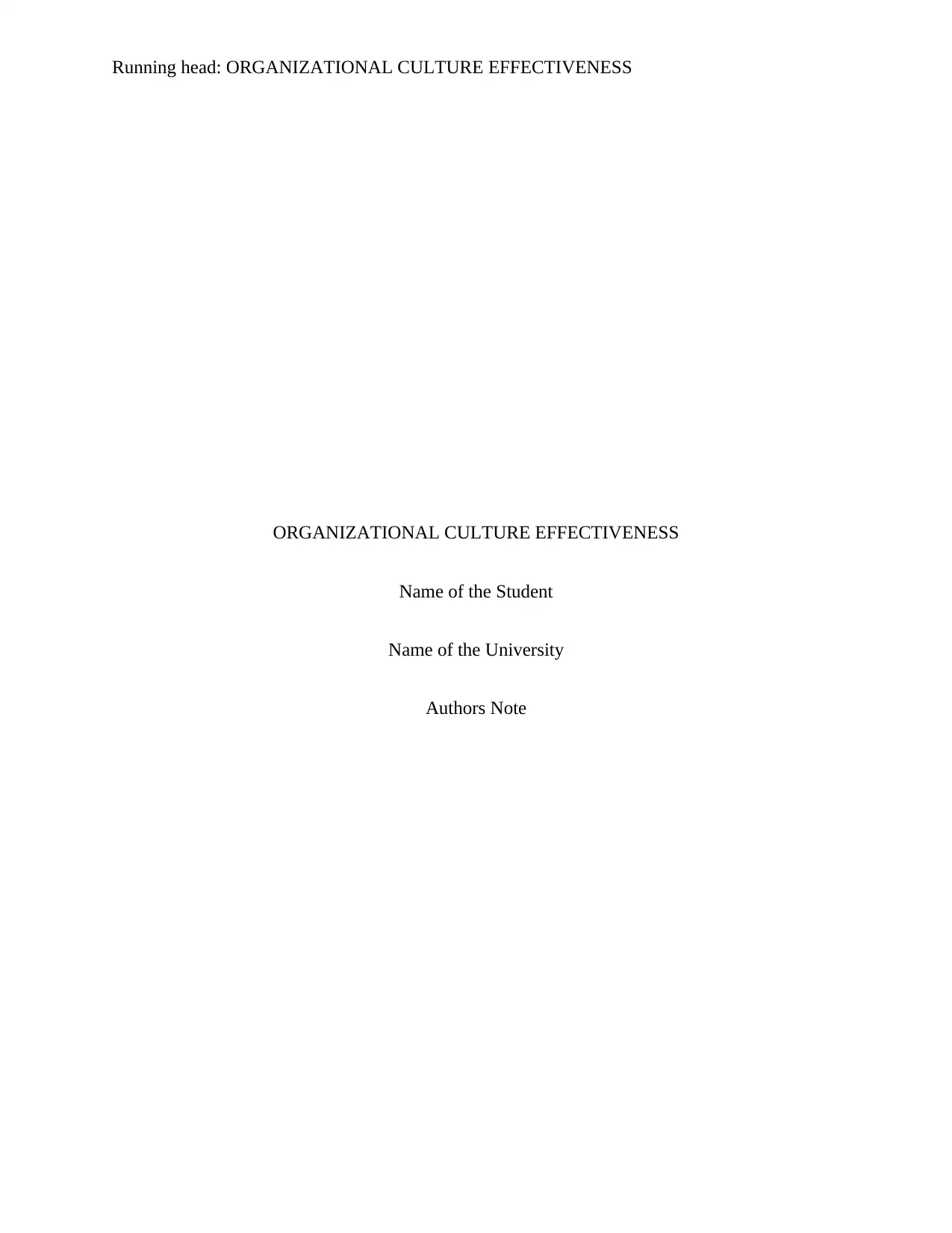
Running head: ORGANIZATIONAL CULTURE EFFECTIVENESS
ORGANIZATIONAL CULTURE EFFECTIVENESS
Name of the Student
Name of the University
Authors Note
ORGANIZATIONAL CULTURE EFFECTIVENESS
Name of the Student
Name of the University
Authors Note
Paraphrase This Document
Need a fresh take? Get an instant paraphrase of this document with our AI Paraphraser
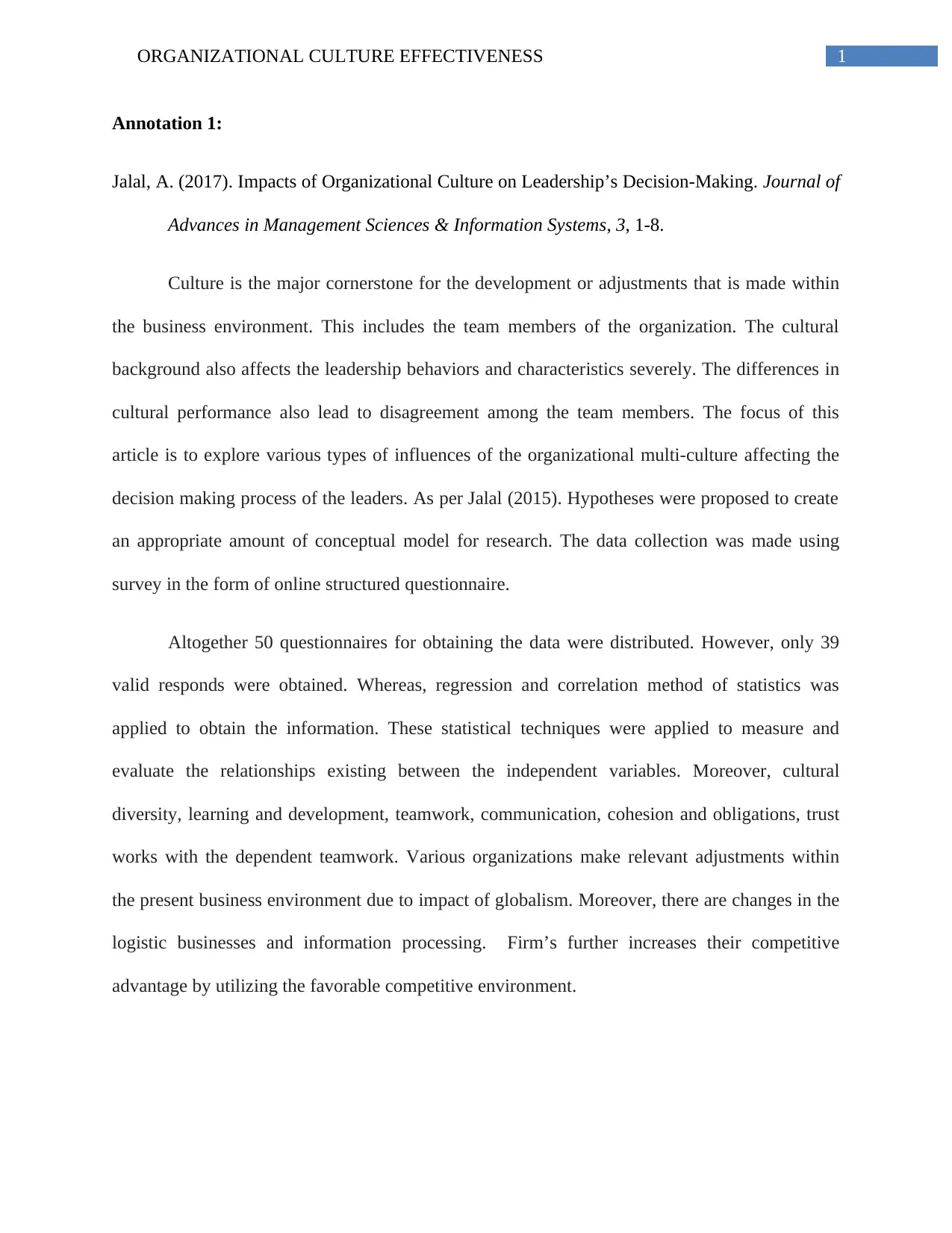
1ORGANIZATIONAL CULTURE EFFECTIVENESS
Annotation 1:
Jalal, A. (2017). Impacts of Organizational Culture on Leadership’s Decision-Making. Journal of
Advances in Management Sciences & Information Systems, 3, 1-8.
Culture is the major cornerstone for the development or adjustments that is made within
the business environment. This includes the team members of the organization. The cultural
background also affects the leadership behaviors and characteristics severely. The differences in
cultural performance also lead to disagreement among the team members. The focus of this
article is to explore various types of influences of the organizational multi-culture affecting the
decision making process of the leaders. As per Jalal (2015). Hypotheses were proposed to create
an appropriate amount of conceptual model for research. The data collection was made using
survey in the form of online structured questionnaire.
Altogether 50 questionnaires for obtaining the data were distributed. However, only 39
valid responds were obtained. Whereas, regression and correlation method of statistics was
applied to obtain the information. These statistical techniques were applied to measure and
evaluate the relationships existing between the independent variables. Moreover, cultural
diversity, learning and development, teamwork, communication, cohesion and obligations, trust
works with the dependent teamwork. Various organizations make relevant adjustments within
the present business environment due to impact of globalism. Moreover, there are changes in the
logistic businesses and information processing. Firm’s further increases their competitive
advantage by utilizing the favorable competitive environment.
Annotation 1:
Jalal, A. (2017). Impacts of Organizational Culture on Leadership’s Decision-Making. Journal of
Advances in Management Sciences & Information Systems, 3, 1-8.
Culture is the major cornerstone for the development or adjustments that is made within
the business environment. This includes the team members of the organization. The cultural
background also affects the leadership behaviors and characteristics severely. The differences in
cultural performance also lead to disagreement among the team members. The focus of this
article is to explore various types of influences of the organizational multi-culture affecting the
decision making process of the leaders. As per Jalal (2015). Hypotheses were proposed to create
an appropriate amount of conceptual model for research. The data collection was made using
survey in the form of online structured questionnaire.
Altogether 50 questionnaires for obtaining the data were distributed. However, only 39
valid responds were obtained. Whereas, regression and correlation method of statistics was
applied to obtain the information. These statistical techniques were applied to measure and
evaluate the relationships existing between the independent variables. Moreover, cultural
diversity, learning and development, teamwork, communication, cohesion and obligations, trust
works with the dependent teamwork. Various organizations make relevant adjustments within
the present business environment due to impact of globalism. Moreover, there are changes in the
logistic businesses and information processing. Firm’s further increases their competitive
advantage by utilizing the favorable competitive environment.
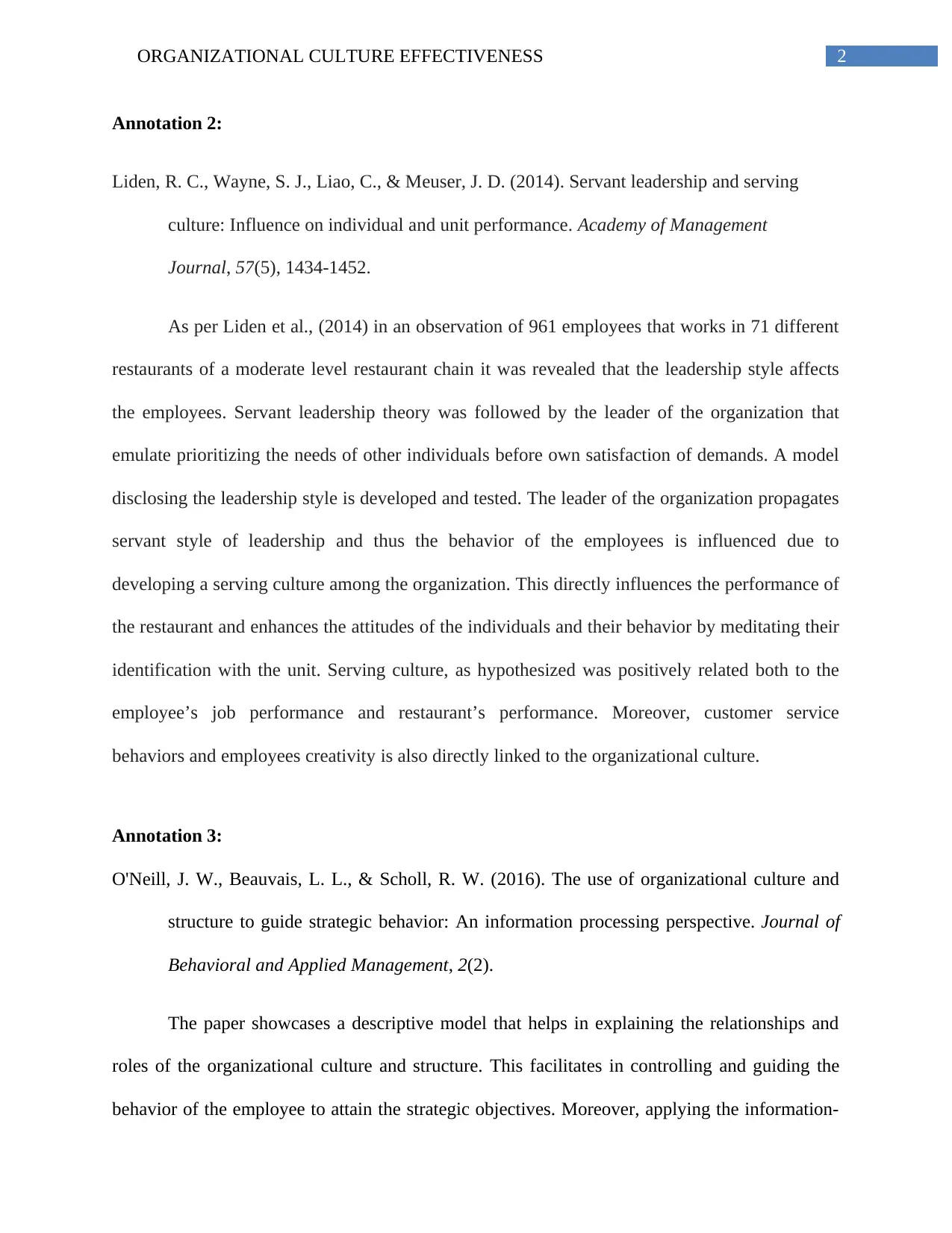
2ORGANIZATIONAL CULTURE EFFECTIVENESS
Annotation 2:
Liden, R. C., Wayne, S. J., Liao, C., & Meuser, J. D. (2014). Servant leadership and serving
culture: Influence on individual and unit performance. Academy of Management
Journal, 57(5), 1434-1452.
As per Liden et al., (2014) in an observation of 961 employees that works in 71 different
restaurants of a moderate level restaurant chain it was revealed that the leadership style affects
the employees. Servant leadership theory was followed by the leader of the organization that
emulate prioritizing the needs of other individuals before own satisfaction of demands. A model
disclosing the leadership style is developed and tested. The leader of the organization propagates
servant style of leadership and thus the behavior of the employees is influenced due to
developing a serving culture among the organization. This directly influences the performance of
the restaurant and enhances the attitudes of the individuals and their behavior by meditating their
identification with the unit. Serving culture, as hypothesized was positively related both to the
employee’s job performance and restaurant’s performance. Moreover, customer service
behaviors and employees creativity is also directly linked to the organizational culture.
Annotation 3:
O'Neill, J. W., Beauvais, L. L., & Scholl, R. W. (2016). The use of organizational culture and
structure to guide strategic behavior: An information processing perspective. Journal of
Behavioral and Applied Management, 2(2).
The paper showcases a descriptive model that helps in explaining the relationships and
roles of the organizational culture and structure. This facilitates in controlling and guiding the
behavior of the employee to attain the strategic objectives. Moreover, applying the information-
Annotation 2:
Liden, R. C., Wayne, S. J., Liao, C., & Meuser, J. D. (2014). Servant leadership and serving
culture: Influence on individual and unit performance. Academy of Management
Journal, 57(5), 1434-1452.
As per Liden et al., (2014) in an observation of 961 employees that works in 71 different
restaurants of a moderate level restaurant chain it was revealed that the leadership style affects
the employees. Servant leadership theory was followed by the leader of the organization that
emulate prioritizing the needs of other individuals before own satisfaction of demands. A model
disclosing the leadership style is developed and tested. The leader of the organization propagates
servant style of leadership and thus the behavior of the employees is influenced due to
developing a serving culture among the organization. This directly influences the performance of
the restaurant and enhances the attitudes of the individuals and their behavior by meditating their
identification with the unit. Serving culture, as hypothesized was positively related both to the
employee’s job performance and restaurant’s performance. Moreover, customer service
behaviors and employees creativity is also directly linked to the organizational culture.
Annotation 3:
O'Neill, J. W., Beauvais, L. L., & Scholl, R. W. (2016). The use of organizational culture and
structure to guide strategic behavior: An information processing perspective. Journal of
Behavioral and Applied Management, 2(2).
The paper showcases a descriptive model that helps in explaining the relationships and
roles of the organizational culture and structure. This facilitates in controlling and guiding the
behavior of the employee to attain the strategic objectives. Moreover, applying the information-
⊘ This is a preview!⊘
Do you want full access?
Subscribe today to unlock all pages.

Trusted by 1+ million students worldwide
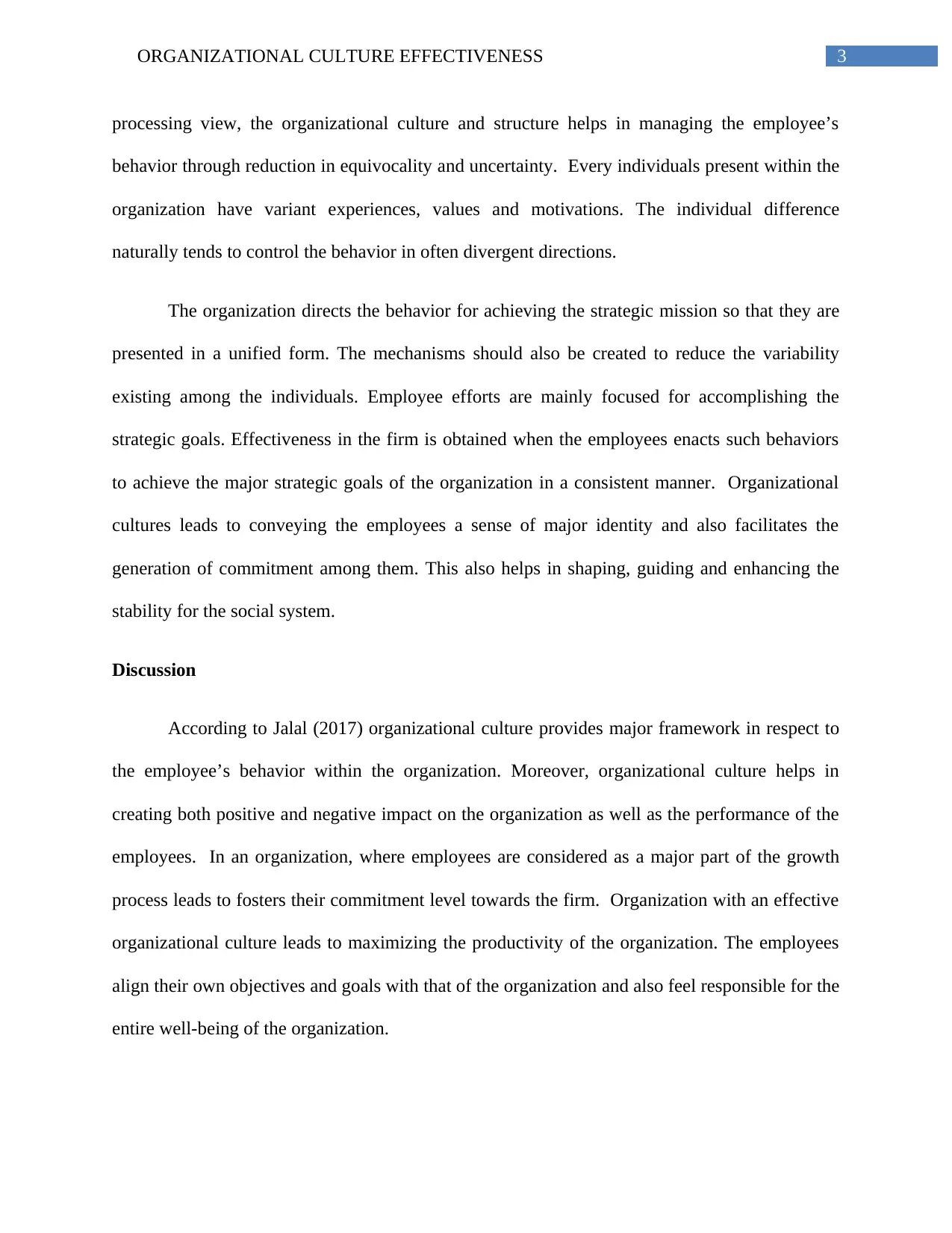
3ORGANIZATIONAL CULTURE EFFECTIVENESS
processing view, the organizational culture and structure helps in managing the employee’s
behavior through reduction in equivocality and uncertainty. Every individuals present within the
organization have variant experiences, values and motivations. The individual difference
naturally tends to control the behavior in often divergent directions.
The organization directs the behavior for achieving the strategic mission so that they are
presented in a unified form. The mechanisms should also be created to reduce the variability
existing among the individuals. Employee efforts are mainly focused for accomplishing the
strategic goals. Effectiveness in the firm is obtained when the employees enacts such behaviors
to achieve the major strategic goals of the organization in a consistent manner. Organizational
cultures leads to conveying the employees a sense of major identity and also facilitates the
generation of commitment among them. This also helps in shaping, guiding and enhancing the
stability for the social system.
Discussion
According to Jalal (2017) organizational culture provides major framework in respect to
the employee’s behavior within the organization. Moreover, organizational culture helps in
creating both positive and negative impact on the organization as well as the performance of the
employees. In an organization, where employees are considered as a major part of the growth
process leads to fosters their commitment level towards the firm. Organization with an effective
organizational culture leads to maximizing the productivity of the organization. The employees
align their own objectives and goals with that of the organization and also feel responsible for the
entire well-being of the organization.
processing view, the organizational culture and structure helps in managing the employee’s
behavior through reduction in equivocality and uncertainty. Every individuals present within the
organization have variant experiences, values and motivations. The individual difference
naturally tends to control the behavior in often divergent directions.
The organization directs the behavior for achieving the strategic mission so that they are
presented in a unified form. The mechanisms should also be created to reduce the variability
existing among the individuals. Employee efforts are mainly focused for accomplishing the
strategic goals. Effectiveness in the firm is obtained when the employees enacts such behaviors
to achieve the major strategic goals of the organization in a consistent manner. Organizational
cultures leads to conveying the employees a sense of major identity and also facilitates the
generation of commitment among them. This also helps in shaping, guiding and enhancing the
stability for the social system.
Discussion
According to Jalal (2017) organizational culture provides major framework in respect to
the employee’s behavior within the organization. Moreover, organizational culture helps in
creating both positive and negative impact on the organization as well as the performance of the
employees. In an organization, where employees are considered as a major part of the growth
process leads to fosters their commitment level towards the firm. Organization with an effective
organizational culture leads to maximizing the productivity of the organization. The employees
align their own objectives and goals with that of the organization and also feel responsible for the
entire well-being of the organization.
Paraphrase This Document
Need a fresh take? Get an instant paraphrase of this document with our AI Paraphraser
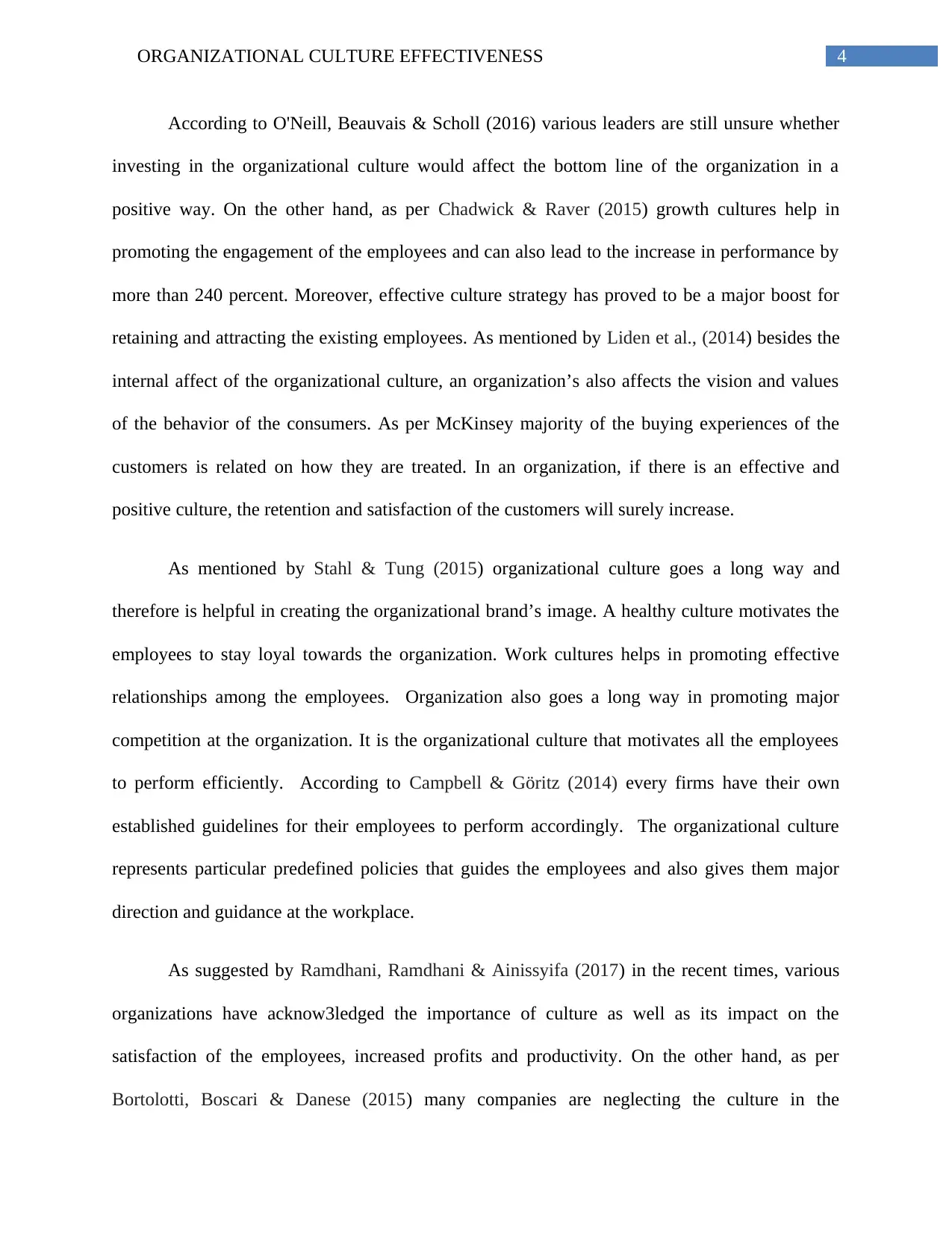
4ORGANIZATIONAL CULTURE EFFECTIVENESS
According to O'Neill, Beauvais & Scholl (2016) various leaders are still unsure whether
investing in the organizational culture would affect the bottom line of the organization in a
positive way. On the other hand, as per Chadwick & Raver (2015) growth cultures help in
promoting the engagement of the employees and can also lead to the increase in performance by
more than 240 percent. Moreover, effective culture strategy has proved to be a major boost for
retaining and attracting the existing employees. As mentioned by Liden et al., (2014) besides the
internal affect of the organizational culture, an organization’s also affects the vision and values
of the behavior of the consumers. As per McKinsey majority of the buying experiences of the
customers is related on how they are treated. In an organization, if there is an effective and
positive culture, the retention and satisfaction of the customers will surely increase.
As mentioned by Stahl & Tung (2015) organizational culture goes a long way and
therefore is helpful in creating the organizational brand’s image. A healthy culture motivates the
employees to stay loyal towards the organization. Work cultures helps in promoting effective
relationships among the employees. Organization also goes a long way in promoting major
competition at the organization. It is the organizational culture that motivates all the employees
to perform efficiently. According to Campbell & Göritz (2014) every firms have their own
established guidelines for their employees to perform accordingly. The organizational culture
represents particular predefined policies that guides the employees and also gives them major
direction and guidance at the workplace.
As suggested by Ramdhani, Ramdhani & Ainissyifa (2017) in the recent times, various
organizations have acknow3ledged the importance of culture as well as its impact on the
satisfaction of the employees, increased profits and productivity. On the other hand, as per
Bortolotti, Boscari & Danese (2015) many companies are neglecting the culture in the
According to O'Neill, Beauvais & Scholl (2016) various leaders are still unsure whether
investing in the organizational culture would affect the bottom line of the organization in a
positive way. On the other hand, as per Chadwick & Raver (2015) growth cultures help in
promoting the engagement of the employees and can also lead to the increase in performance by
more than 240 percent. Moreover, effective culture strategy has proved to be a major boost for
retaining and attracting the existing employees. As mentioned by Liden et al., (2014) besides the
internal affect of the organizational culture, an organization’s also affects the vision and values
of the behavior of the consumers. As per McKinsey majority of the buying experiences of the
customers is related on how they are treated. In an organization, if there is an effective and
positive culture, the retention and satisfaction of the customers will surely increase.
As mentioned by Stahl & Tung (2015) organizational culture goes a long way and
therefore is helpful in creating the organizational brand’s image. A healthy culture motivates the
employees to stay loyal towards the organization. Work cultures helps in promoting effective
relationships among the employees. Organization also goes a long way in promoting major
competition at the organization. It is the organizational culture that motivates all the employees
to perform efficiently. According to Campbell & Göritz (2014) every firms have their own
established guidelines for their employees to perform accordingly. The organizational culture
represents particular predefined policies that guides the employees and also gives them major
direction and guidance at the workplace.
As suggested by Ramdhani, Ramdhani & Ainissyifa (2017) in the recent times, various
organizations have acknow3ledged the importance of culture as well as its impact on the
satisfaction of the employees, increased profits and productivity. On the other hand, as per
Bortolotti, Boscari & Danese (2015) many companies are neglecting the culture in the

5ORGANIZATIONAL CULTURE EFFECTIVENESS
organization and are losing major talented employees. This also creates negative impact on the
growth prospects of the organization in future. It is significant to build an effective and great
culture as well as productive team. The organizational culture and standards can also attract new
employees while retaining the old ones. If rewards and incentives are provided to the best
performers, it also helps in making the employees encouraged. This further helps in boosting the
performance of the employees and increasing the productivity of the organization.
organization and are losing major talented employees. This also creates negative impact on the
growth prospects of the organization in future. It is significant to build an effective and great
culture as well as productive team. The organizational culture and standards can also attract new
employees while retaining the old ones. If rewards and incentives are provided to the best
performers, it also helps in making the employees encouraged. This further helps in boosting the
performance of the employees and increasing the productivity of the organization.
⊘ This is a preview!⊘
Do you want full access?
Subscribe today to unlock all pages.

Trusted by 1+ million students worldwide
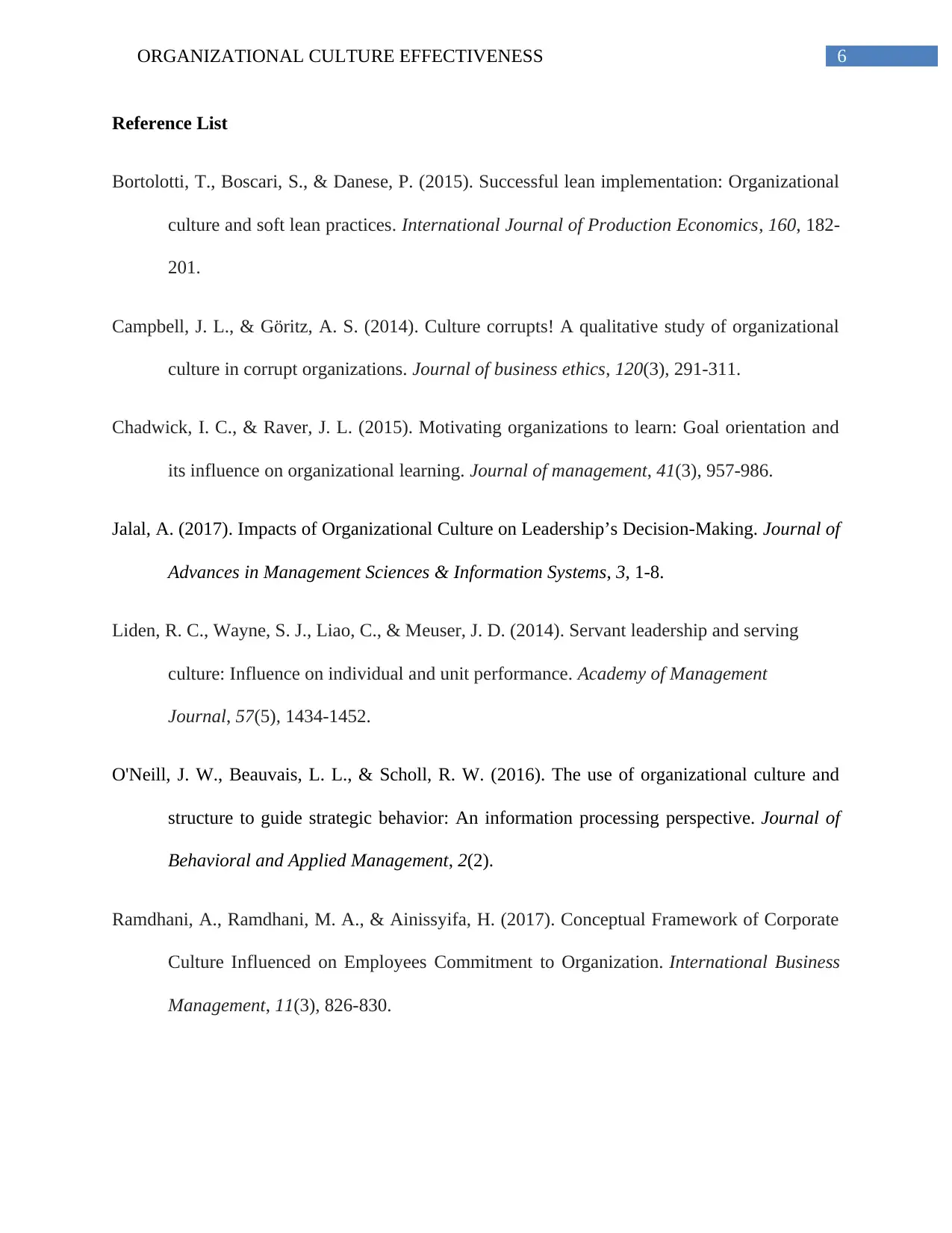
6ORGANIZATIONAL CULTURE EFFECTIVENESS
Reference List
Bortolotti, T., Boscari, S., & Danese, P. (2015). Successful lean implementation: Organizational
culture and soft lean practices. International Journal of Production Economics, 160, 182-
201.
Campbell, J. L., & Göritz, A. S. (2014). Culture corrupts! A qualitative study of organizational
culture in corrupt organizations. Journal of business ethics, 120(3), 291-311.
Chadwick, I. C., & Raver, J. L. (2015). Motivating organizations to learn: Goal orientation and
its influence on organizational learning. Journal of management, 41(3), 957-986.
Jalal, A. (2017). Impacts of Organizational Culture on Leadership’s Decision-Making. Journal of
Advances in Management Sciences & Information Systems, 3, 1-8.
Liden, R. C., Wayne, S. J., Liao, C., & Meuser, J. D. (2014). Servant leadership and serving
culture: Influence on individual and unit performance. Academy of Management
Journal, 57(5), 1434-1452.
O'Neill, J. W., Beauvais, L. L., & Scholl, R. W. (2016). The use of organizational culture and
structure to guide strategic behavior: An information processing perspective. Journal of
Behavioral and Applied Management, 2(2).
Ramdhani, A., Ramdhani, M. A., & Ainissyifa, H. (2017). Conceptual Framework of Corporate
Culture Influenced on Employees Commitment to Organization. International Business
Management, 11(3), 826-830.
Reference List
Bortolotti, T., Boscari, S., & Danese, P. (2015). Successful lean implementation: Organizational
culture and soft lean practices. International Journal of Production Economics, 160, 182-
201.
Campbell, J. L., & Göritz, A. S. (2014). Culture corrupts! A qualitative study of organizational
culture in corrupt organizations. Journal of business ethics, 120(3), 291-311.
Chadwick, I. C., & Raver, J. L. (2015). Motivating organizations to learn: Goal orientation and
its influence on organizational learning. Journal of management, 41(3), 957-986.
Jalal, A. (2017). Impacts of Organizational Culture on Leadership’s Decision-Making. Journal of
Advances in Management Sciences & Information Systems, 3, 1-8.
Liden, R. C., Wayne, S. J., Liao, C., & Meuser, J. D. (2014). Servant leadership and serving
culture: Influence on individual and unit performance. Academy of Management
Journal, 57(5), 1434-1452.
O'Neill, J. W., Beauvais, L. L., & Scholl, R. W. (2016). The use of organizational culture and
structure to guide strategic behavior: An information processing perspective. Journal of
Behavioral and Applied Management, 2(2).
Ramdhani, A., Ramdhani, M. A., & Ainissyifa, H. (2017). Conceptual Framework of Corporate
Culture Influenced on Employees Commitment to Organization. International Business
Management, 11(3), 826-830.
Paraphrase This Document
Need a fresh take? Get an instant paraphrase of this document with our AI Paraphraser

7ORGANIZATIONAL CULTURE EFFECTIVENESS
Stahl, G. K., & Tung, R. L. (2015). Towards a more balanced treatment of culture in
international business studies: The need for positive cross-cultural scholarship. Journal of
International Business Studies, 46(4), 391-414.
Stahl, G. K., & Tung, R. L. (2015). Towards a more balanced treatment of culture in
international business studies: The need for positive cross-cultural scholarship. Journal of
International Business Studies, 46(4), 391-414.
1 out of 8
Related Documents
Your All-in-One AI-Powered Toolkit for Academic Success.
+13062052269
info@desklib.com
Available 24*7 on WhatsApp / Email
![[object Object]](/_next/static/media/star-bottom.7253800d.svg)
Unlock your academic potential
Copyright © 2020–2025 A2Z Services. All Rights Reserved. Developed and managed by ZUCOL.





